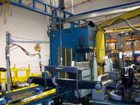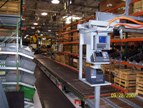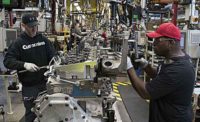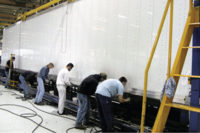
The Kendallville, IN, manufacturing Facility of
Hendrickson U.S.A. LLC was formally recognized as a VPP Star site in November
2008. All photos courtesy Hendrickson U.S.A LLC
“Overall, we have six VPP Star facilities located in Ohio, Indiana, Tennessee and South Dakota,” says William Linneweh, CSP, CHMM, EHS Manager, truck systems group. “We have one additional facility that underwent the VPP evaluation in 2010 and are awaiting official word from OSHA’s National Office on their VPP status. Hopefully it will be Star or Merit.”

Encompassing 201,000 square feet, the
Hendrickson manufacturing facility produces a wide variety of suspensions for
the commercial vehicle industry.
In Focus: Kendallville, IN
The company’s Kendallville, IN, manufacturing facility was formally recognized as a VPP Star site in November 2008 after a 15-month journey. In August 2007, Hendrickson partnered with Indiana OSHA and four VPP Star companies (Frito Lay, Von Duprin, International Aerospace Tubes and Eli Lilly) to benchmark their efforts. This benchmarking exercise, involving more than 100 Hendrickson associates, provided insight into both the benefits of VPP as well as the process for achieving Star status.The Kendallville facility underwent its first comprehensive VPP evaluation in July 2008 before being recognized as a Star winner four months later. Linneweh says the facility is scheduled for its three-year VPP re-evaluation within Indiana OSHA in November 2011.
A total of 165 people work at Kendallville, which encompasses 201,000 square feet (177,000 for manufacturing and 24,000 for warehouse).
“In 2009, the global economic downturn impacted our production capacity in Kendallville-dropping OEM production to its lowest levels since the early 1980s, says Linneweh. “Despite this downturn, manufacturing operations continued to evolve as lean process flow improvements and new suspension technologies evolved. In 2010, supplier demand in both the OEM and aftermarket sectors increased, and manufacturing capacity has continued to expand.
A wide variety of suspensions for the commercial vehicle industry are assembled there, including the RT, HN, HAULMAX and PRIMAAX vocational suspensions; and HAS, HTB and Airtek on-highway suspensions. OEM customers of these suspensions include Navistar International, Mack/Volvo and Paccar.

Assembly workstations feature line automation, material handling
aids (magnetic, pneumatic and custom-made), and ergonomically designed tools
and work station components.
Lean Processes and Ergonomics
The facility primarily uses station by station models for assembly. Lean manufacturing processes have streamlined operations to permit work centers to accommodate sound ergonomic principles that minimize lifting, stretching and reaching into crates and containers while assembly takes place.Heavier suspension components are handled with various magnetic, pneumatic and custom-made devices. These devices limit the risk factors for sprain/strain injuries on both the upper musculoskeletal system and lower back.
Hendrickson established its ergonomics team in 2006, well before applying for Star status in Spring 2008. The team-which was composed of production associates, manufacturing engineers, maintenance staff and human resources-received comprehensive training on industrial ergonomics.
Training focused on understanding and recognizing ergonomic risk factors, as well as the process for developing actions to eliminate or mitigate these risk factors. Following the team training, work centers were identified for “Ergonomic Blitzes” by reviewing historical incidents and employee feedback/surveys.
Each Ergonomic Blitz involves the team targeting a specific work center/assembly process and spending a few hours identifying ergonomic risk factors. Video is taken of the assembly process, and associates are interviewed at length so that details of the process are fully understood. “Involving assembly associates within the ergonomics program is viewed as a critical element because they often identify ergonomic risk factors and offer solutions for eliminating/mitigating these risk factors.”
A series of forms helps guide the team through the process. Once evaluation is completed, the team develops a series of action items to address the identified risk factors. Much emphasis is placed on engineering risk factors out of the assembly process, followed by administrative controls. Examples of engineering solutions include:
*Material handling devices such as hoists, cranes and other custom designed lifting aids.
*Automation of assembly processes.
*Workstation layout changes to modify the walk distances, reach distances and workstation heights.
*Tool design changes to minimize trigger forces, maximize tool-handle diameters and weight limits of tools or the installation of tool balancers.
*Installation of auto leveling lift and tilt tables at work stations that utilize bins/totes for material storage.
“The ergonomics program was recognized as an area of excellence by the OSHA team,” says Linneweh. “As such, no significant assembly changes were recommended by the OSHA team or VPP process. More importantly, in 2010, Kendallville’s injuries rate were less than 62 percent of our industry average (based on NACIS Code 336330).”

Suspension kit components are fed to workers on automated
pallet conveying systems. Kitting workstations feature ergonomic matting and tilt/lift
tables.
A Stronger Commitment to Safety
Earning the VPP Star strengthened Hendrickson’s commitment to safety and health at the Kendallville plant. It also has made the workers there very proud and safety a way of life.“Many companies strive for delivering great products to the satisfaction of the customers,” says Linneweh. “The VPP Star compliments theses efforts by striving to deliver safer products. Personnel who work at a VPP Star site value their safety and that of their coworkers, and believe in safety excellence. They know a comprehensive ergonomics program brings substantial value to assembly processes.”



